The Old West, often referred to as the Wild West, encompasses the period after the Civil War, the rest of the 1800’s, and the early part of the 20th century. There is much legend surrounding American History of the Wild West when it comes to American outlaws and lawmen. The odd thing is that on occasion, the two were interchangeable and a lawman might have been a bandit previously in another state. Here are some profiles of famous outlaws of the American wild west.
1. Billy the Kid (The Regulators and The Rustlers)
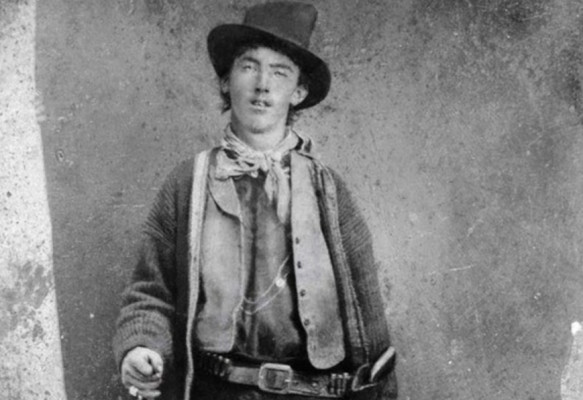
Henry McCarty, aka, William Henry Bonney, aka, Billy the Kid was a teenage outlaw and the most notorious gunman in the history of the wild west. Billy the Kid’s exact date of birth and place is not known, and historians and biographers are still trying to solve the mystery. Possible birth dates, according to historians, are November 20, 1859, and September 17, 1859. Orphan at fifteen, Billy had been fending for himself as a horse thief and by the age of seventeen, Billy had already killed a man in a fight, claiming it to be an act of self-defense.
In just a few short years transformed himself from a skinny orphan boy to the most feared man in the West and an enduring western icon. According to legend, he killed 21 men during his days as an outlaw, one for each year of his life, though he likely killed far fewer than that number.On the run from the authorities, McCarty moved to Arizona. Known as “The Kid,” McCarty switched to the opposition to fight with John Tunstall under the name “The Regulators.” The second gang of Billy the Kid was called “The Rustlers“ (Tom Folliard, Charlie Bowdre, Tom Pickett, Billy the Kid, Dirty Dave Rudabaugh and Billy Wilson).
Billy was sentenced to hang for the murder of Sheriff Brady and two weeks before his execution, on April 28, Billy escaped after killing the guards. His murders turned him into the nation’s most wanted man.
On July 14, 1881, a local bartender and former buffalo hunter named Pat Garrett finally tracked Billy down at a ranch near Fort Summer, New Mexico. Billy was visiting a girlfriend and Garrett gained access to the house and surprised him in the dark.Garrett fired a bullet through Billy’s chest.
“Тhe Kid“ was dead at age 21.
2. Dalton Gang
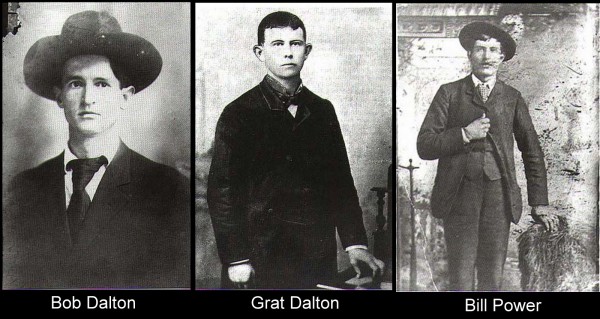
They were known as the Dalton Brothers because three of its members were brothers. A gang made up of outlaws and lawmen in the American Old West. They were known as train and bank robbers. The members of the gang were , Emmett “Em“ Dalton, born in 1871, Robert “Bob“ Renick Dalton, born 1869 and Gratton “Grat“ Dalton, born in 1861. William M. “Bill“ Dalton, born in 1866, was an outlaw as well and mainly rode with the Wild Bunch (one of the loosely organized outlaw gangs operating out of the Hole-in-the-Wall in Wyoming during the Old West era in the United States).
For a very short time the brothers served on the side of the law, working as U.S. Deputy Marshals.Bob Dalton, who was the wildest of the gang, killed a man when he was 19, claiming it was in the line of duty.
On October 5, 1892, the gang set out to rob the C.M. Condon & Company’s Bank and the First National Bank on opposite sides of the street in Coffeyville, Kansas. They were disguised with fake beards, but that wasn’t enough because one of the townspeople recognized them and word got out that the bank was being robbed. When the Dalton brothers walked out of the bank, a hail of bullets forced them back into the building.That gave the townspeople enough time to gather force and they were met by wild gunfire from vigilante citizens. Every member was killed except for Emmett Dalton. He was wounded and spent 14 years in Kansas Penitentiary in Lansing.
The Dalton gang is no more, and travelers through the Indian Territory could travel without fear. The country, and the railroads and express companies, especially, breathed easier. The country was rid of the desperate gang, but the riddance cost Coffeyville some of its best blood.
3. Clanton Gang (They called themselves “The Cowboys“)
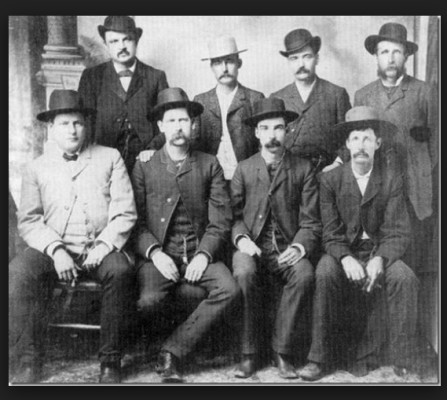
“The Cowboys“ were a loosely organized gang of outlaws who operated along the Mexican border, stealing cattle, robbing stage coaches (a large, closed horse-drawn vehicle formerly used to carry passengers and often mail along a regular route between two places), ambushing teamsters and committing murder.
The head of the Clanton Clan in Cochise County, Arizona, was Newman Haynes “Old Man“ Clanton (1816-1881). Newman and his sons Ike, Billy and Phin arrived in Arizona Territory in 1873 when they were involved in freighting and ranching. The “Cowboys“ also included Tom and Frank McLaury, Curly Bill Brocious, Johnny Ringo, Pete Spence and several others.
The “Old Cowboy“ Newman was accused by Wyatt Earps (lawman of the American West) of rustling, ambushing, smuggling and harboring rustlers, but he was never arrested for those crimes.
In July 1881, Newman and several members of the gang ambushed a group of Mexican cowboys driving a herd through Guadalupe Canyon, killing 19 of them. That incident was later known as the Guadalupe Canyon Massacre. But the tables were turned and the Mexican cowboys were seeking revenge for the earlier ambush and Newman and four of his men were killed in the same canyon.
4. The Innocents
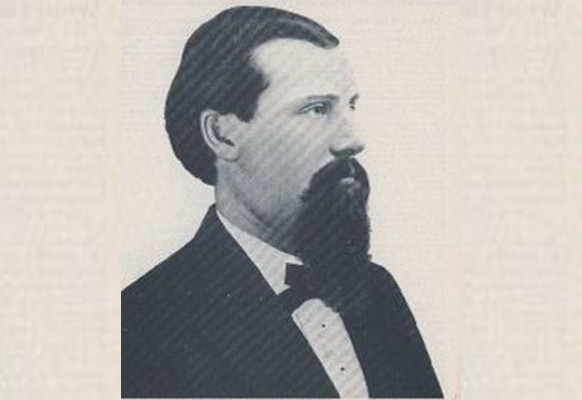
They were an alleged gang of outlaw road agents from Montana, led by Henry Plummer, during the gold rush of the 1860s. They terrorized the road between Bannack and Virginia City and allegedly killed over one hundred people during this violent time. The group of possibly more than 100 members preyed on miners and were so named because they’d answer to a secret password, “I am innocent” and they used a particular secret knot in their tie to recognize each other. The group would split themselves up into smaller units of men so they could hit different mining camps simultaneously.
Many residents soon became frustrated by the amount of crime that was occurring. In 1863, the citizens were getting fed up and formed a vigilante committee to hunt the men down (a group of men calling themselves the Vigilante Committee).
There is really little evidence connecting Plummer with any crime committed in the Bannack area, other than the “confession” of a criminal attempting to save his own life. However, in January 1864, Henry Plummer was accused of leading the group and he was executed by the Vigilante Committee and other 21 men were hanged.
5. Butch Cassidy’s Wild Bunch
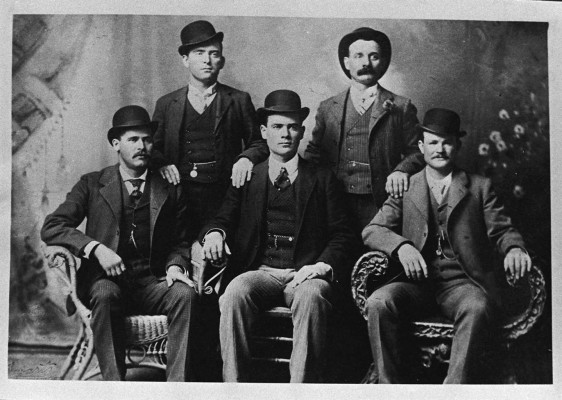
Robert Leroy Parker, born April 13, 1866, better known as Butch Cassidy, was one of the most famous names of the Old West. A thief and murderer who formed one of the most prolific bank robbery gangs in history. Butch Cassidy began his life of crime as a cattle rustler and horse thief and became notorious for holding up banks and trains. He was working in a butcher’s shop and, according to popular legend, became known as Butcher Cassidy, which morphed into Butch Cassidy.
In 1894, Cassidy was found guilty of stealing a horse and sentenced to two years in the state penitentiary. After 18 months behind bars, he was released for good behavior. After prison, Cassidy reunited with members of the Wild Bunch, a circle of criminals, a loose-knit band of men (Elzy Lay, Harvey “Kid Curry“ Logan, Ben Kilpatrick, Harry Tracy, Will “News“ Carver, Laura Bullion and George Curry) who started out as rustlers and horse thieves and became notorious for bank and train robberies.
He and his fellow bandits developed a pattern for committing crimes that involved doing reconnaissance on the place they planned to rob, as well as stashing supplies and extra horses along their intended getaway route. Cassidy’s gang, The Wild Bunch, became notorious for pulling off holdups throughout the West in the 1890s.
The facts surrounding Butch Cassidy’s death are uncertain. Most likely gunned down by Bolivian soldiers after a botched attempt to steal a mining company payroll with his companion Sundance Kid. There were multiple reports the two men had returned to the United States where they lived for a number of years under aliases. More than a century after their presumed deaths, the true fate of Butch and Sundance remains a mystery.
6. Five Joaquins Gang
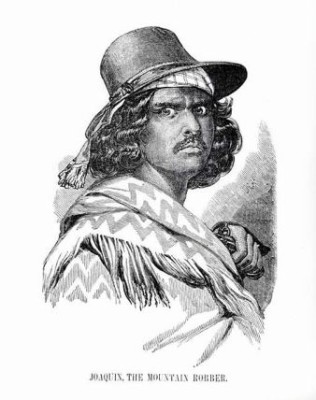
Joaquin Murrieta (1829-1853), a Mexican-born man, moved to California in 1849 to seek treasures from the Gold Rush. He had come to California with a gang of family and friends who soon become known as “The Five Joaquins“ (Joaquin Murrieta, Joaquin Botellier, Joaquin Carrilo, Joaquin Ocomorenia and Joaquin Valenzuela.) With the help of their three-fingered friend, Jack Garcia, they decided to stop their dreams of striking gold and choose a different path by 1853. The gang is believed to have killed up tp 28 Chinese and 13 Anglo-Americans. Joaquin Murrieta is known to be one of their most ruthless bandits for stealing cows, horses and also attacks on wagons, many which resulted in several murders.
The state compensated the California Rangers (veterans of the Mexican-American War) $150 a month and promised them $1000 if they captured the wanted men. In July of 1853, the rangers finally caught them, three of the Mexicans were killed, two others were captured.
As proof of this, the hand was cut off of “Three Fingered Jack“. They even cut off Murrieta’s head and put it in a jar of alcohol so members of the public could see it.
In 1919, Johnston Mc Culley supposedly received his inspiration for his fictional character Don Diego de la Vega better known as Zorro from the 1854 book entitled ”The Life and Adventures of Joaquin Murreta, The Celebrated California Bandit ” by John Rollin Ridge. John heard about a Mexican miner who had turned to banditry and was intrigued by the story.
7. Soap Gang
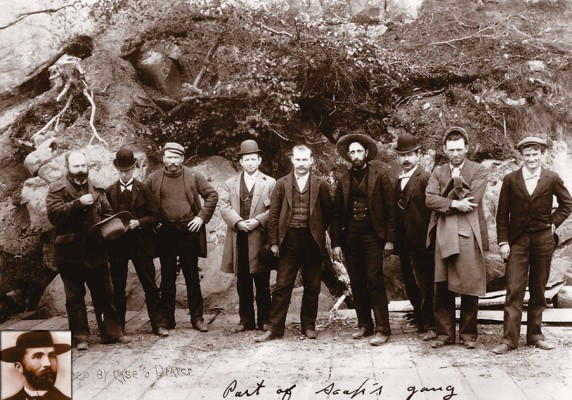
Photo credit: True West Archives
The lure of gold brought more than honest miners and foolish adventurers to the North. It also brought con men, thieves and opportunists who got rich by preying on gullible miners. Notorious among them was Jefferson “Soapy” Smith (Jefferson Randolph Smith II). His most famous scam, the prize package soap sell racket, presented him with the sobriquet of “Soapy”, which remained with him to his death. The gang of over 100 ruffians ruled Skagway in 1897 and 1898. They ran crooked gambling halls, freight companies that hauled nothing, telegraph offices that had no telegraph link.
In Denver, Soapy began to make a name for himself across the country as a bad man. Denver is also where he entered into the arena of political fixing, where, for favors, he could sway the outcome of city, county, and state elections. By 1887, he was reputedly involved with most of the criminal bunko activities in the city.
On the evening of July 8, the vigilance committee organized a meeting on the Juneau wharf. With a Winchester rifle draped over his shoulder, Soapy began an argument with Frank H. Reid, one of four guards blocking his way to the wharf. A gunfight, known as the Shootout on Juneau Wharf began unexpectedly, and both men were fatally wounded. Soapy died on the spot with a bullet to the heart.
The rest of the gang soon drifted apart.
8. Rufus Buck Gang
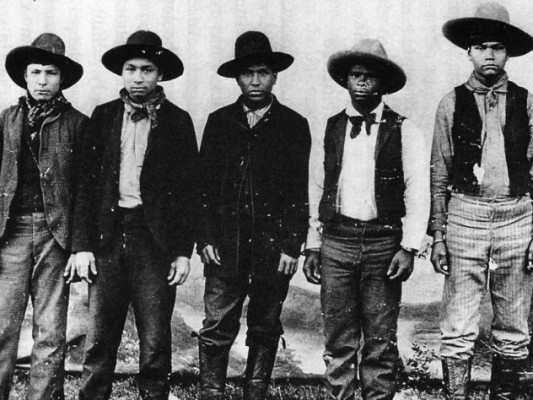
The Buck Gang was an outlaw multi-racial gang of members who were part African American and part Creek-Indian. The gang rose to prominence in July of 1895. Named after their leader, Rufus Buck, the gang had a total of five members. Sam Sampson and Maoma July were both Creek Indians. All of them had been apprehended on minor offenses and served time in the Fort Smith jail prior to their crime spree that summer.
The Buck Gang went on a vicious two-week spree of robbery, rape, and murder. The apparently random violence terrified not only the local white settlers but also the neighboring Indians and African-American freedmen. the gang began holding up various stores and ranches in the Fort Smith area. But the violence wasn’t random. The gang’s leader, Rufus Buck, the 18-year-old son of a black mother and Creek father, burned with a zealot’s passion: he dreamed that his gang’s spree would trigger an Indian uprising that would expel the illegal white majority and reclaim the whole Territory for its native people.
They were finally caught up with outside Muskogee, Oklahoma by a combined force of U.S. Deputy Marshals and the Creek Lighthorse police, led by Marshal S. Morton Rutherford on August 10th. The execution of the five members of the Rufus Buck Gang on July 1, 1896 was the second to last execution to occur at Fort Smith. The Buck Gang were the only men to die on the gallows in Fort Smith for rape.
9. Daly Gang
John Daly (1839-1864) and his gang were known for terrorizing townspeople with the violent treatment of those who resisted their thievery. Though called the Daly Gang, the mastermind behind the group was actually “Three-Fingered Jack“ McDowell, who, along with John Daly, operated an Aurora, Nevada saloon The saloon quickly became known as a place where beatings, gunfights, mayhem, and murder were the norm.
They operated without interference until the gang murdered a man named William R. Johnson on February 1 1864, who had killed one of their associates named Jim Sears when he was attempting to steal a horse the previous year.Slitting Johnson’s throat and setting him on fire, they left the gruesome sight for all to see.
Fed up, the horror-stricken citizens soon formed a vigilante group and attacked McDowell’s saloon on February 5, 1864. Dragging McDowell, Daly, Buckley, and Masterson from the saloon they locked them up while they quickly constructed a gallows.
A short time later, all for men were hanged outside Armory Hall in Aurora.
10. Dodge City Gang
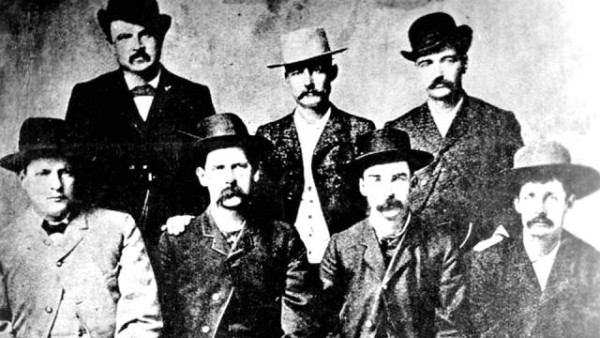
Photo credit: List25.com
The Dodge City Gang was a group of Kansas gunfighters and gamblers, led by Hyman G. Neill, better known as Hoodoo Brown, who dominated the political and economic life of Las Vegas, New Mexico. Other members of the gang were John Joshua Webb, “Dirty“ Dave Rudabaugh and Mysterious Dave Mather From 1879 through 1880, Hoodoo led the Dodge City Gang on stagecoach and train robberies, murders, thievery and municipal corruption. Hoodoo’s position as Coroner enabled him to install the gang as the “Coroner’s Jury”, which they used to determine whether or not killings were in self-defense. This position enabled Hoodoo’s gang to cover up most of their crimes. The Dodge City Gang was firmly in control of a criminal cartel bent on sticking their fingers up at the law. The gang participated in several stagecoach and train robberies, organized cattle rustling, and were said to have been responsible for multiple murders and lynchings.
By the summer of 1880, the citizens of Las Vegas, New Mexico organized a team of vigilantes against the gang. Webb, Mather and Rudabaugh were arrested. Hoodoo Brown was not killed but instead driven from the state. Many other members of the organization left town. The power of the gang lasted only a matter of months. It was doomed by the greed and excesses of its members, and their inability to disguise their acts.
Reports from a descendant of Hyman G. Neill indicate that Hoodoo Brown died in Torreon, Coahuila, Mexico.
sources: Wikipedia, Legendsofamerica.com